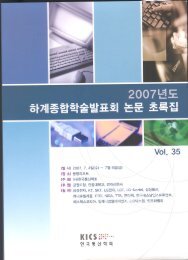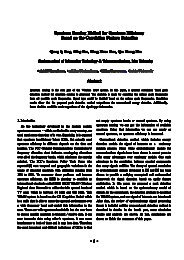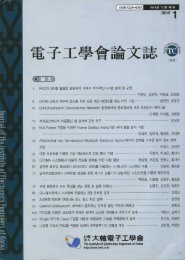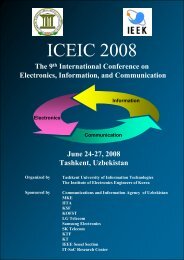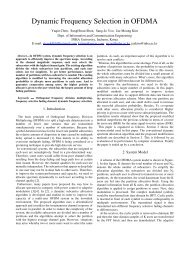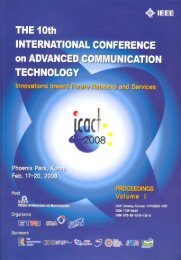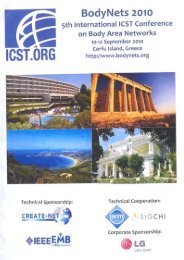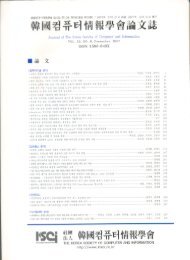Power Allocation and User Satisfaction-Based Switching Method in ...
Power Allocation and User Satisfaction-Based Switching Method in ...
Power Allocation and User Satisfaction-Based Switching Method in ...
Create successful ePaper yourself
Turn your PDF publications into a flip-book with our unique Google optimized e-Paper software.
<strong>Power</strong> <strong>Allocation</strong> <strong>and</strong> <strong>User</strong> <strong>Satisfaction</strong>-<strong>Based</strong><br />
<strong>Switch<strong>in</strong>g</strong> <strong>Method</strong> <strong>in</strong> Cognitive Radio MIMO System<br />
Jaebum Cho, Sungjeen Jang, Wonsik Jung, Jaemoung Kim<br />
INHA-WiTLAB, INHA University<br />
253 Yonghyun-dong, Nam-gu, Incheon, Korea<br />
{jaebum.cho, sungjeen.jang, wonsik}@witlab.kr, jaekim@<strong>in</strong>ha.ac.kr<br />
Abstract—Secondary users (SUs) should have power constra<strong>in</strong>ts<br />
because primary users (PUs) should not be <strong>in</strong>terfered by SUs <strong>in</strong><br />
cognitive radio (CR) network. Therefore it is important for SUs<br />
to maximize throughput <strong>and</strong> ensure quality of service (QoS) on<br />
the premise of generat<strong>in</strong>g no <strong>in</strong>terference to PUs. In this paper,<br />
SUs are equipped with multiple antennas. Multiple-<strong>in</strong>put<br />
multiple-output (MIMO) wireless communication systems can<br />
offer high data rate or reliability through spatial multiplex<strong>in</strong>g or<br />
diversity. Therefore we present a method which user satisfactionbased<br />
on switch<strong>in</strong>g between spatial multiplex<strong>in</strong>g <strong>and</strong> transmit<br />
diversity to maximize total user satisfaction. When we use spatial<br />
multiplex<strong>in</strong>g, user satisfaction is formulated as a function with<br />
data rate <strong>and</strong> power consumed. In case we use transmit diversity,<br />
user satisfaction is formulated as a function with reliability <strong>and</strong><br />
power consumed. For estimat<strong>in</strong>g reliability, we provide a novel<br />
bit error rate (BER) equation. And we use different power<br />
allocation method <strong>in</strong> each case. We apply capped water-fill<strong>in</strong>g<br />
method for spatial multiplex<strong>in</strong>g <strong>and</strong> Lagrangian method for<br />
transmit diversity. Simulation results show that proposed<br />
switch<strong>in</strong>g scheme <strong>in</strong>crease user satisfaction. And we study the<br />
effect of <strong>in</strong>terference of PU on the performance<br />
Keywords: cognitive radio, MIMO, power allocation, switch<strong>in</strong>g<br />
I. INTRODUCTION<br />
In recently years, with the rapid development of various<br />
wireless systems, the dem<strong>and</strong> of radio spectrum has <strong>in</strong>creased.<br />
But this dem<strong>and</strong> is not satisfied because resource of radio<br />
spectrum is limited. To ensure future growth of wireless<br />
system, it is necessary to <strong>in</strong>crease the spectrum efficiency. For<br />
this, CR system is proposed as a new technique [1], [2]. CR<br />
system is designed to improve spectrum efficiency by<br />
allow<strong>in</strong>g opportunistic spectrum access to SUs, on the premise<br />
of generat<strong>in</strong>g no <strong>in</strong>terference to PUs while tak<strong>in</strong>g advantage of<br />
the available spectrum resources. As the PUs have higher<br />
priority <strong>in</strong> us<strong>in</strong>g the spectrum <strong>and</strong> should not be <strong>in</strong>terfered by<br />
SUs, SUs are subject to constra<strong>in</strong>ts. So it is hard for SUs to<br />
maximize the throughput or to ensure the QoS with power<br />
constra<strong>in</strong>t.<br />
One of the techniques which improve throughput or QoS<br />
This work was supported by the National Research Foundation of Korea<br />
(NRF) grant funded by the Korea government M<strong>in</strong>istry of Education, Science<br />
<strong>and</strong> Technology (MEST) (No. 2010-0008000). And this research was also<br />
supported by the M<strong>in</strong>istry of Knowledge Economy (MKE), Korea, under the<br />
Information Technology Research Center (ITRC) support program supervised<br />
by the National IT Industry Promotion Agency (NIPA), (NIPA-2010-C1090-<br />
111-0007).<br />
of SUs is to employ multiple antennas at transmitter <strong>and</strong><br />
receiver. So we can improve quality, capacity <strong>and</strong> reliability of<br />
SUs by employ<strong>in</strong>g MIMO technique. In recent years, there are<br />
some works to improve performance of SUs with a s<strong>in</strong>gle<br />
antenna or multiple antennas. For <strong>in</strong>stance, weighted sum rate<br />
maximization problem for the SUs MIMO broadcast channel<br />
(BC) has been studied under the multi-constra<strong>in</strong>t [3]. In [4],<br />
the ergodic capacity of a s<strong>in</strong>gle SU l<strong>in</strong>k was considered under<br />
the <strong>in</strong>stantaneous or average power constra<strong>in</strong>t. Other works for<br />
power load<strong>in</strong>g <strong>and</strong> jo<strong>in</strong>t beamform<strong>in</strong>g can be founded [5], [6].<br />
In this paper, switch<strong>in</strong>g between spatial multiplex<strong>in</strong>g <strong>and</strong><br />
transmit diversity is proposed because it is clear that there is a<br />
tradeoff between multiplex<strong>in</strong>g <strong>and</strong> diversity <strong>in</strong> MIMO system.<br />
To combat the impact of fad<strong>in</strong>g on the error rate, diversity or<br />
transmit diversity techniques are employed. The pr<strong>in</strong>ciple of<br />
diversity is to transmit same <strong>in</strong>formation over multiple<br />
antennas, <strong>and</strong> then the received signals on all antennas are<br />
comb<strong>in</strong>ed to <strong>in</strong>crease the signal quality [7]. On the other h<strong>and</strong>,<br />
to <strong>in</strong>crease transmission rate or capacity of the communication<br />
system, spatial multiplex<strong>in</strong>g is employed. The pr<strong>in</strong>ciple of<br />
multiplex<strong>in</strong>g is to divide data stream <strong>in</strong>to multiple antennas,<br />
<strong>and</strong> each substream is transmitted <strong>and</strong> received over a<br />
different antenna to <strong>in</strong>crease the capacity [8]. The scheme<br />
proposed <strong>in</strong> [10] uses the m<strong>in</strong>imum Euclidean distance, which<br />
can be used to estimate the BER, to switch between<br />
multiplex<strong>in</strong>g <strong>and</strong> diversity <strong>in</strong> MIMO system <strong>and</strong> the scheme<br />
proposed <strong>in</strong> [11] uses received signal-to-<strong>in</strong>terference-plusnoise<br />
ratio (SINR), which can be used to estimate the<br />
throughput, to switch between multiplex<strong>in</strong>g <strong>and</strong> diversity <strong>in</strong><br />
MIMO system. Similarly, conventional switch<strong>in</strong>g schemes<br />
consider just one term as criterion. We consider comb<strong>in</strong>ation<br />
with power consumption. Thus we have to use different<br />
switch<strong>in</strong>g criterion. We propose a user satisfaction-based<br />
switch<strong>in</strong>g scheme. It is expected that the proposed user<br />
satisfaction-based switch<strong>in</strong>g scheme can <strong>in</strong>crease user<br />
satisfaction than a scheme with spatial multiplex<strong>in</strong>g or<br />
transmit diversity that is solely employed.<br />
New metric of user satisfaction is <strong>in</strong> the form of numerical<br />
value which represents comb<strong>in</strong>ation of power consumption<br />
<strong>and</strong> achievable data rate, reliability. For example, if users<br />
prefer high data rate, power efficiency is lower, whereas if<br />
users prefer high power efficiency, data rate is lower. Previous<br />
user satisfaction has two terms, data rate satisfaction <strong>and</strong><br />
power consumption satisfaction [9]. However the <strong>in</strong>fluence of<br />
channel fad<strong>in</strong>g <strong>and</strong> <strong>in</strong>terference from PUs <strong>in</strong> CR networks
don’t guarantee reliability of SUs l<strong>in</strong>k. Therefore, we consider<br />
reliability as well as data rate <strong>and</strong> power consumption. In other<br />
words, we consider target data rate <strong>and</strong> target BER related to<br />
reliability satisfaction. In case we use transmit diversity, we<br />
provide a new BER equation of Space-Time Block Cod<strong>in</strong>g<br />
(STBC), <strong>and</strong> then estimate BER for reliability.<br />
We apply two difference power allocation methods to<br />
maximize user satisfaction <strong>in</strong> each case, data rate <strong>and</strong><br />
reliability satisfaction. For data rate, allocated power is set by<br />
water-fill<strong>in</strong>g method <strong>and</strong> optimal power level of water-fill<strong>in</strong>g<br />
is updated by an iterative algorithm. For reliability,<br />
Lagrangian function <strong>and</strong> Karush-Kuhn-Tucker (KKT)<br />
conditions are applied.<br />
The rema<strong>in</strong>der of paper is organized as follows. CR system<br />
model <strong>and</strong> formulate optimization problem with power<br />
constra<strong>in</strong>t <strong>and</strong> channel allocated power constra<strong>in</strong>t are<br />
presented <strong>in</strong> Section II. In Section III, we consider data rate<br />
problem, BER equation expression <strong>in</strong> STBC-MIMO system<br />
<strong>and</strong> power allocation algorithm for orthogonal transmission.<br />
Simulation results of proposed system are given <strong>in</strong> Section IV.<br />
Conclusions are given <strong>in</strong> the last section.<br />
A. System Model<br />
II. SYSTEM MODEL<br />
Consider a CR-MIMO system where K SUs coexist with L<br />
PUs. And we assume the availability of a set of N channels.<br />
SUs can receive <strong>and</strong> transmit over multiple channels. SUs are<br />
equipped with Nr receive antennas <strong>and</strong> Nt transmit antennas.<br />
The transmit-receive signal model from the SU to another SU<br />
can be represented as:<br />
y=Hx+H x +z (1)<br />
where y denotes received signal vector. H = [h11, …, hij]<br />
denotes the channel matrix with hij be<strong>in</strong>g the channel response<br />
from SUi to the SUj. x is the transmit signal vector. The<br />
channel ga<strong>in</strong> is represented by hij=aijbij/(1+dij 2 ). dij denote the<br />
distance between SUi’s transmitter <strong>and</strong> SUj’s receiver. aij 2<br />
follows the lognormal distribution with mean 1 <strong>and</strong> bij follows<br />
the complex Gaussian distribution with zero mean <strong>and</strong> unit<br />
variance. H =[h 1, …, h L] denotes channel matrix where h L is<br />
the channel response from PUs’s transmitter to the SU, x is<br />
transmit signal vector from PUs. Channel ga<strong>in</strong> is h l=(d ij/d l) 2 α l,<br />
dl denotes the distance between PU’s transmitter <strong>and</strong> SU’s<br />
receiver. And we assume that all SUs are at the same distance<br />
dl. α l is modeled as circularly symmetric complex Gaussian<br />
(CSCG) r<strong>and</strong>om variables (RVs) with mean zero <strong>and</strong> variance<br />
1. z is the Gaussian noise vector whose entries are assumed to<br />
be <strong>in</strong>dependent Gaussian RVs with mean zero <strong>and</strong> variance σ 2 .<br />
Similar to [9], K SUs are r<strong>and</strong>omly deployed <strong>in</strong> a unit<br />
area <strong>and</strong> are try<strong>in</strong>g to access the vacant channels. Each user<br />
has a power constra<strong>in</strong>t P k max , k = 1, …, K. There is also a<br />
constra<strong>in</strong>t on the amount of power that can be allocated <strong>in</strong><br />
each channel, P n mask , n = 1, …, N.<br />
We consider the case with a s<strong>in</strong>gle PU. And we assume<br />
block fad<strong>in</strong>g channel model, i.e., channel matrix H, H are<br />
fixed dur<strong>in</strong>g each transmission block <strong>and</strong> change<br />
<strong>in</strong>dependently from one block to another accord<strong>in</strong>g to ergodic<br />
r<strong>and</strong>om process.<br />
B. Problem Formulation<br />
In this paper, we consider the problem of switch<strong>in</strong>g<br />
between multiplex<strong>in</strong>g <strong>and</strong> diversity. So we def<strong>in</strong>e two user<br />
satisfactions equations.<br />
tar<br />
max<br />
S f ( R , R ) ( 1<br />
) g(<br />
P , P )<br />
<br />
k,<br />
mul k mul k k<br />
k k k<br />
tar<br />
max<br />
S f ( B , B ) ( 1<br />
) g(<br />
P , P )<br />
<br />
k,<br />
div k div k k<br />
k k k<br />
In [9], it considers data rate <strong>and</strong> power consumption terms,<br />
i.e. (2). However the phenomena of channel fad<strong>in</strong>g <strong>and</strong><br />
<strong>in</strong>terference from PUs <strong>in</strong> CR networks don’t guarantee<br />
reliability of SUs l<strong>in</strong>k. Therefore, we consider reliability as<br />
well as data rate <strong>and</strong> power consumption. (2) is applied when<br />
multiplex<strong>in</strong>g is selected, (3) is applied when diversity is<br />
selected.<br />
We assume kth SU has an expected target data rate, Rk tar ,<br />
expected target BER, Bk tar . Where γ k is a weighted factor for<br />
control between power consumption satisfaction <strong>and</strong> other two<br />
satisfactions. Small γ k implies that users focus on sav<strong>in</strong>g its<br />
battery energy while accept<strong>in</strong>g a lower data rate or reliability.<br />
On other h<strong>and</strong>, large γ k means that users focus on enhanc<strong>in</strong>g<br />
its data rate or reliability with a short high battery life. Data<br />
rate satisfaction fmul(Rk, Rk tar ), BER satisfaction fdiv(Bk, Bk tar )<br />
<strong>and</strong> power consumption satisfaction g(Pk, Pk max ) are def<strong>in</strong>ed<br />
as:<br />
f<br />
f<br />
mul<br />
div<br />
tar<br />
1<br />
Rk<br />
Rk<br />
tar <br />
( Rk<br />
, Rk<br />
) R<br />
<br />
k<br />
tar<br />
0 Rk<br />
R<br />
tar<br />
k<br />
R<br />
k<br />
( B , B<br />
k<br />
tar<br />
k<br />
1<br />
<br />
) log( Bk<br />
)<br />
tar<br />
log(<br />
Bk<br />
)<br />
B<br />
k<br />
B<br />
B<br />
tar<br />
k<br />
tar<br />
k<br />
B<br />
k<br />
<br />
1<br />
max P<br />
max<br />
<br />
k<br />
g( Pk<br />
, Pk<br />
) 1<br />
0 P<br />
max<br />
k P<br />
<br />
k<br />
P<br />
k<br />
First term of user satisfaction (2), (3) can be conventional<br />
data rate satisfaction (
Fig. 1. <strong>Switch<strong>in</strong>g</strong> between sprtial multiplex<strong>in</strong>g <strong>and</strong> transmit diversity<br />
based on user satisfaction<br />
<br />
s.<br />
t.<br />
max S(<br />
P)<br />
K<br />
k 1<br />
N<br />
P<br />
<br />
<br />
n1<br />
P<br />
P<br />
kn<br />
kn<br />
P<br />
P<br />
mask<br />
n<br />
max<br />
k<br />
We consider orthogonal transmission, one channel can be<br />
occupied by only one user, to allocate channel. Next section,<br />
we show appropriated power allocation method for data rate<br />
<strong>and</strong> reliability.<br />
III. TRANSMIT POWER ALLOCATION<br />
In this section, we consider power allocation methods for<br />
data rate problem <strong>and</strong> reliability problem to improve total user<br />
satisfaction. <strong>Power</strong> allocation method for data rate is similar to<br />
[9]. In case reliability problem, STBC for transmit diversity is<br />
applied <strong>and</strong> we estimate BER related to reliability by<br />
formulat<strong>in</strong>g a new equation.<br />
A. Data rate Problem<br />
Data rate problem is expla<strong>in</strong>ed <strong>in</strong> detail <strong>in</strong> [9]. So we<br />
simply expla<strong>in</strong> this part. First, the achievable data rate of SUk<br />
with multiple antennas is<br />
R<br />
k<br />
<br />
N<br />
<br />
mk<br />
kn<br />
n1<br />
t1<br />
<br />
2 <br />
t Pknt<br />
log <br />
<br />
1<br />
<br />
2 <br />
<br />
A={α kn} is channel allocation matrix. P knt= 0 if α kn= 0.<br />
After we apply s<strong>in</strong>gular value decomposition (SVD) on Hkn,<br />
i.e, Hkn=U V, then take power allocation on mt = m<strong>in</strong>(Nt, Nr)<br />
parallel subchannels. The channel ga<strong>in</strong>s are the diagonal<br />
elements of , λ t, t=1,…,mk.<br />
Performance of SUs can be affected by <strong>in</strong>terference from<br />
PUs. Thus, we additionally consider <strong>in</strong>terference from PUs to<br />
ensure QoS of SUs. Apply<strong>in</strong>g the QR decomposition to the<br />
channel matrix H of SUs, <strong>and</strong> we can write H=QR, where Q =<br />
[q1, …, qM] has orthogonal columns, <strong>and</strong> def<strong>in</strong>e M as the rank<br />
2 2 L H H of H. ςi =ς + l=1 p lqi (h lh l )qi is the <strong>in</strong>terference-plus<br />
noise power [6].<br />
We use capped water-fill<strong>in</strong>g method to allocate power each<br />
users. Allocated power is Pknt=m<strong>in</strong> max Lk- ς2 2 mask λt ,0 ,Pnt .<br />
If SUs are equipped with two transmit-receive antennas,<br />
power constra<strong>in</strong>t for first antenna is same as the case of s<strong>in</strong>gle<br />
antenna. However power constra<strong>in</strong>t for second antenna is<br />
Pn mask m<strong>in</strong>us allocated power at first antenna.<br />
Optimal power level Lk satisfy<strong>in</strong>g all constra<strong>in</strong>ts is<br />
Lk=m<strong>in</strong>([Lk P ,Lk R ,Lk o ]).<br />
1) Lk o : if the condition holds that when Pk max is used, the<br />
achievable data rate Rk Rk tar .<br />
Total user satisfaction<br />
2) Lk P : when allocat<strong>in</strong>g all power Pk max<br />
3) Lk R : achieves Rk tar<br />
We propose a channel-by-channel optimization (CBCO)<br />
method [12]. We outl<strong>in</strong>e the algorithm to maximize total user<br />
satisfaction. First, set l = 0 <strong>and</strong> we choose an <strong>in</strong>itial channel<br />
allocation matrix Al, <strong>and</strong> then power allocation matrix Pl is<br />
found to maximize each user satisfaction based on the optimal<br />
power level Lk. the achieved total user satisfaction is denote<br />
by Sl. The process repeats until the algorithm converges Sl −<br />
Sl−1
equipped with 2 2 antennas. PU’s transmit power is p l=10dB<br />
<strong>and</strong> distance ratio is dij/dl=0.5. We can also know performance<br />
degradation by effect of PU <strong>in</strong>terference. If a channel is<br />
allocated to the user with the smallest noise floor, then largest<br />
contribution can be obta<strong>in</strong>ed towards total user satisfaction.<br />
On the other h<strong>and</strong>, if channel is allocated to the user with the<br />
largest noise floor, then smallest contribution can be obta<strong>in</strong>ed<br />
towards total user satisfaction.<br />
B. Reliability Problem<br />
For MPSK digital demodulation, we assume that<br />
wireless channel is flat Rayleigh fad<strong>in</strong>g environment. The<br />
conditional probability density function (pdf) of STBC-<br />
MIMO system is presented as [13] :<br />
<br />
m n<br />
STBC 2<br />
( <br />
n,<br />
R | X ) Q 2C<br />
n R K M b<br />
x<br />
c<br />
, <br />
k <br />
j1<br />
i1<br />
Pe c<br />
<br />
where k=log2M, KM=ks<strong>in</strong> 2 ( π<br />
M ), X={x1,1,…,xn,m}, xij=αi,j <strong>and</strong> αij is path ga<strong>in</strong> from <strong>in</strong>dependent complex Gaussian<br />
r<strong>and</strong>om variables. Specially, for x≥0, we approximate Qfunction<br />
as [14].<br />
Q proposed<br />
approx<br />
i,<br />
j<br />
1<br />
2 1<br />
2<br />
( x,<br />
1, 2 ) : exp( 1x<br />
) exp( <br />
2 x ) <br />
12<br />
4<br />
In STBC-MIMO system, estimated BER can be expressed<br />
through substitut<strong>in</strong>g (9) <strong>in</strong>to (10).<br />
<br />
<br />
<br />
<br />
2<br />
B ( 1<br />
2 ) <br />
k<br />
k<br />
where Φ1= 1<br />
12 exp -2ρ1Cn,Rc K Pk 2 2<br />
M<br />
ς<br />
2 λ1+λ2 ,<br />
i<br />
Φ2= 1<br />
4 exp -2ρ2Cn,Rc K Pk 2 2<br />
M<br />
ς<br />
2 (λ1+λ2) .<br />
i<br />
We also def<strong>in</strong>e the <strong>in</strong>terference-plus noise power,<br />
2 2 L H H ςi =ς + l=1 p lqi h lh l qi [6]. We substitute (11) <strong>in</strong>to (3),<br />
<strong>and</strong> then <strong>in</strong>to (7). The Lagrangian function of the equation is<br />
given by.<br />
<br />
k<br />
L(<br />
P,<br />
,<br />
v)<br />
<br />
log( B<br />
tar<br />
(<br />
P<br />
2<br />
log (<br />
) <br />
<br />
k<br />
max<br />
1<br />
P ) v(<br />
P<br />
k<br />
<br />
2<br />
<br />
)<br />
<br />
<br />
mask<br />
P )<br />
k<br />
2<br />
<br />
Where <strong>and</strong> v are Lagrangian coefficients. The KKT<br />
conditions are listed as:<br />
<br />
1<br />
3 3<br />
3 exp<br />
<br />
<br />
) 6k<br />
1<br />
3exp<br />
v 0<br />
( 2 1Pk<br />
3)<br />
<br />
( P ) <br />
k<br />
tar<br />
log( B 2 1 k 3<br />
<br />
<br />
<br />
<br />
<br />
( ) 0<br />
max<br />
P P <br />
Total user satisfaction<br />
3.8<br />
3.6<br />
3.4<br />
3.2<br />
3<br />
2.8<br />
2.6<br />
2.4<br />
k<br />
mask<br />
Pk<br />
v( P ) 0 <br />
where Φ3 = −2Cn ,R c KM (λ<br />
2<br />
1+λ2 2<br />
)<br />
ς<br />
2 .<br />
i<br />
We rearrange Eq. (13) for Pk. allocated power to each SUs<br />
is given by (16). Each antenna can be allocated same power<br />
Pk/2.<br />
<br />
P k<br />
Y <br />
ln<br />
<br />
3{<br />
(<br />
2 1)<br />
3<br />
Y}<br />
<br />
where Y= λ+v+ (1-γ k)<br />
Pmax log(Btar )<br />
γk 2x2 diversity no PU <strong>in</strong>terference<br />
2x2 diversity with PU <strong>in</strong>terference<br />
2.2<br />
-20 -18 -16 -14 -12 -10 -8 -6 -4 -2 0<br />
Noise power[dB]<br />
2<br />
1<br />
<br />
2(<br />
) <br />
+ ρ1Φ3<br />
6k .<br />
2<br />
1<br />
3<br />
<br />
The parameter λ <strong>and</strong> v can be obta<strong>in</strong>ed through<br />
substitut<strong>in</strong>g (16) <strong>in</strong>to (14) <strong>and</strong> (15). Without loss of generality,<br />
we can assume v=0. Please note the denot<strong>in</strong>g difference<br />
between Lagrangian multiplier (λ) <strong>and</strong> channel ga<strong>in</strong> λ 1, λ 2 .<br />
Calculated λ is given by<br />
( 2<br />
1)<br />
3<br />
1 3 1<br />
k<br />
max<br />
3exp<br />
( ) 6k<br />
k 3exp<br />
<br />
tar <br />
log( B ) (<br />
2<br />
1)<br />
3<br />
2 1 3 P<br />
<br />
Fig. 3. show total user satisfaction by us<strong>in</strong>g Lagrangian<br />
method with diversity for reliability satisfaction. SUs are<br />
equipped with 2 2 antennas. PU’s transmit power is p l=<br />
10dB <strong>and</strong> distance ratio is dij/dl = 0.5. We can also know<br />
performance degradation by effect of PU <strong>in</strong>terference. Two<br />
cases between data rate <strong>and</strong> reliability have similar graph<br />
pattern. However <strong>User</strong> satisfaction curve for reliability is<br />
gentler than data rate case.<br />
Fig. 3. Comparison of total user satisfaction with diversity
IV. SIMULATION RESULTS OF SWITCHING<br />
In this section, we test the performance of switch<strong>in</strong>g<br />
between multiplex<strong>in</strong>g <strong>and</strong> diversity to improve performance of<br />
SUs communication l<strong>in</strong>k. We use prior user satisfaction value<br />
as switch<strong>in</strong>g criterion. To evaluate the efficiency of proposed<br />
method, we simulate K=4 SUs r<strong>and</strong>omly deployed <strong>in</strong> unit area<br />
<strong>and</strong> N = 7, L = 1, Pn mask = 0.5, Pk max = 2, Rk tar = 8, Bk tar = 0.001,<br />
γ k= 0.5, Nt = Nr = 2. When diversity is selected by switch<strong>in</strong>g<br />
with BPSK modulation, ρ 1,ρ 2 =(0.48, 0.79) [14]. Lower<br />
bound is achievable when no power is allocated. S<strong>in</strong>ce γ k=<br />
0.5, lower bound is 0.5 <strong>and</strong> upper bound is 1 for each users.<br />
We obta<strong>in</strong>ed all results us<strong>in</strong>g Monte Carlo simulations.<br />
The performance improvements of the proposed switch<strong>in</strong>g<br />
system are provided <strong>in</strong> Fig. 4. Fig. 5. First, we consider the<br />
case which ignores the <strong>in</strong>terference from the PU to the SUs.<br />
Fig. 4. shows three curves <strong>in</strong>dicat<strong>in</strong>g multiplex<strong>in</strong>g, diversity<br />
<strong>and</strong> switch<strong>in</strong>g results. The spatial multiplex<strong>in</strong>g <strong>and</strong> transmit<br />
diversity curves cross at approximately noise power = -13dB.<br />
Spatial multiplex<strong>in</strong>g is preferred for noise power < -13dB<br />
while transmit diversity is preferred for noise power > -13dB.<br />
And proposed switch<strong>in</strong>g scheme performs follow<strong>in</strong>g better<br />
one or better than two cases around cross po<strong>in</strong>t.<br />
We next evaluate the effect of the <strong>in</strong>terference from the PU<br />
on the switch<strong>in</strong>g scheme. Fig. 5. shows also three curves.<br />
Aga<strong>in</strong> we consider p l = 10dB <strong>and</strong> dij/dl = 1/2. As expected,<br />
the overall performance is degraded. The spatial multiplex<strong>in</strong>g<br />
<strong>and</strong> transmit diversity curves cross at approximately noise<br />
power = -15dB. The multiplex<strong>in</strong>g curve performs better one at<br />
noise power is smaller than cross po<strong>in</strong>t. However diversity<br />
curve is better at high noise power. Performance of <strong>Switch<strong>in</strong>g</strong><br />
is similar to Fig. 4.<br />
In fact, if two approaches <strong>in</strong> the MIMO channel have same<br />
transmit power, spatial multiplex<strong>in</strong>g performance is better than<br />
transmit diversity one <strong>in</strong> high noise power, s<strong>in</strong>ce spatial<br />
multiplex<strong>in</strong>g has diversity ga<strong>in</strong> on the order of the number of<br />
receive antenna, <strong>in</strong> this case second order, while transmit<br />
diversity has diversity ga<strong>in</strong> on the order of the product of the<br />
number of transmit <strong>and</strong> receive antennas, <strong>in</strong> this case forth<br />
order. But we consider comb<strong>in</strong>ation with power consumption.<br />
So these results are achievable.<br />
We also have to consider <strong>in</strong>terference plus noise power to<br />
PU s<strong>in</strong>ce PU have higher priority <strong>in</strong> CR system. Fig. 6. Show<br />
<strong>in</strong>terference plus noise power to PU <strong>in</strong> each case. We can see<br />
all of cases have same value <strong>in</strong> high noise power <strong>and</strong> little<br />
different value <strong>in</strong> low noise power. But <strong>in</strong> generally, it is<br />
<strong>in</strong>dicated similar value <strong>in</strong> overall noise power. So we can<br />
improve performance of SUs without <strong>in</strong>creas<strong>in</strong>g <strong>in</strong>terference<br />
to PU.<br />
V. CONCLUSTION<br />
In this paper, we consider K SUs who have two<br />
constra<strong>in</strong>ts to m<strong>in</strong>imize or no <strong>in</strong>terference to PU <strong>in</strong> an ad hoc<br />
manner, try<strong>in</strong>g to access N available channel. We propose<br />
power allocation methods <strong>and</strong> a user satisfaction-based<br />
switch<strong>in</strong>g between spatial multiplex<strong>in</strong>g <strong>and</strong> transmit diversity<br />
<strong>in</strong> CR-MIMO system.<br />
If the multiplex<strong>in</strong>g is selected by switch<strong>in</strong>g, we formulate<br />
Total user satisfaction<br />
Total user satisfaction<br />
4<br />
3.8<br />
3.6<br />
3.4<br />
3.2<br />
3<br />
2.8<br />
2.6<br />
2.4<br />
2.2<br />
2x2 multiplex<strong>in</strong>g no pu <strong>in</strong>terference<br />
2x2 diversity with no <strong>in</strong>terference<br />
2x2 switch<strong>in</strong>g with no <strong>in</strong>terference<br />
2<br />
-20 -18 -16 -14 -12 -10 -8 -6 -4 -2 0<br />
Noise power[dB]<br />
Fig. 4. <strong>Switch<strong>in</strong>g</strong> result of multiplex<strong>in</strong>g <strong>and</strong> diversity with no PU<br />
<strong>in</strong>terference<br />
3.8<br />
3.6<br />
3.4<br />
3.2<br />
3<br />
2.8<br />
2.6<br />
2.4<br />
2.2<br />
2x2 multiplex<strong>in</strong>g with pu <strong>in</strong>terference<br />
2x2 diversity with with <strong>in</strong>terference<br />
2x2 switch<strong>in</strong>g with with <strong>in</strong>terference<br />
2<br />
-20 -18 -16 -14 -12 -10 -8 -6 -4 -2 0<br />
Noise power[dB]<br />
Fig. 5. <strong>Switch<strong>in</strong>g</strong> result of multiplex<strong>in</strong>g <strong>and</strong> diversity with PU<br />
<strong>in</strong>terference<br />
<strong>in</strong>terference plus noise power to PU<br />
15<br />
10<br />
5<br />
multiplex<strong>in</strong>g<br />
diversity<br />
proposed switch<strong>in</strong>g method<br />
0<br />
-20 -18 -16 -14 -12 -10 -8 -6 -4 -2 0<br />
Noise power[dB]<br />
Fig. 6. Interference plus noise power to PU
user satisfaction <strong>in</strong> both data rate <strong>and</strong> power consumption. The<br />
otherwise, diversity is selected; we formulate user satisfaction<br />
<strong>in</strong> both reliability <strong>and</strong> power consumption. Then s<strong>in</strong>ce tradeoff<br />
between diversity <strong>and</strong> multiplex<strong>in</strong>g, switch<strong>in</strong>g scheme should<br />
be an effective approach to enhance the systems.<br />
As power allocation methods, we use capped water-fill<strong>in</strong>g<br />
method <strong>and</strong> CBCO algorithm for data rate satisfaction. On the<br />
other h<strong>and</strong>, for reliability satisfaction, Lagrangian method <strong>and</strong><br />
KKT conditions are applied. For reliability representation, we<br />
estimate BER by us<strong>in</strong>g Q-function <strong>in</strong> STBC-MIMO system.<br />
The performance improvement of proposed switch<strong>in</strong>g scheme<br />
<strong>and</strong> performance comparisons are demonstrated through<br />
simulations.<br />
REFERENCES<br />
[1] Federal Communications Commission, “Facilitat<strong>in</strong>g opportunities for<br />
flexible, efficient, <strong>and</strong> reliable spectrum use employ<strong>in</strong>g cognitive radio<br />
technologies, notice of proposed rule mak<strong>in</strong>g <strong>and</strong> order, FCC 03-022,”<br />
Dec. 2003.<br />
[2] S. Hayk<strong>in</strong>, Cognitive Radio: bra<strong>in</strong>-empowerd wireless communications.<br />
Selected Areas <strong>in</strong> Communications, IEEE Journal on, 23(2):201-220, Feb.<br />
2005.<br />
[3] Lan Zhang, Yan X<strong>in</strong>, <strong>and</strong> Y<strong>in</strong>g-Chang Liang, “Weighted Sum Rate<br />
Optimization for Cognitive Radio MIMO Broadcast Channels,” IEEE<br />
Trans. on Wireless Commun., vol. 8, no. 6, pp. 2950-2959, June 2009<br />
[4] A. Ghasemi <strong>and</strong> E. S. Sousa, “Fundamental limits of spectrum-shar<strong>in</strong>g <strong>in</strong><br />
fad<strong>in</strong>g environment,” IEEE Trans. Wireless Commun, vol. 6, no. 2, pp.<br />
649-658, Feb. 2007.<br />
[5] Gaurav Bansal, Md. Jahangir Hossa<strong>in</strong>, <strong>and</strong> Vijay K. Bhargava, ”Adaptive<br />
<strong>Power</strong> Load<strong>in</strong>g for OFDM-based Cognitive Radio Systems,”<br />
Communications, 2007. ICC '07. IEEE International Conference on, pp.<br />
5137-5142, Aug 2007<br />
[6] Lan Zhang, Y<strong>in</strong>g-Chang Liang, <strong>and</strong> Yan X<strong>in</strong>, “Jo<strong>in</strong>t Beamform<strong>in</strong>g <strong>and</strong><br />
<strong>Power</strong> <strong>Allocation</strong> for Multiple Access Channel <strong>in</strong> Cognitive Radio<br />
Networks,” IEEE Journal. Sel. Areas Commun, pp. 38-51, Jan 2008<br />
[7] S. M. Alamouti, “A simple transmit diversity technique for wireless<br />
communications,” IEEE J. Sel. Areas Commun., vol. 16, no. 8, pp.<br />
1451–1458, Oct. 1998.<br />
[8] G. J. Fosch<strong>in</strong>i, “Layered space-time architecture for wireless<br />
communication <strong>in</strong> a fad<strong>in</strong>g environment when us<strong>in</strong>g multiple antennas,”<br />
Bell Labs. Tech. J., vol. 1, no. 2, pp. 41–59, 1996.<br />
[9] Qi Cheng <strong>and</strong> Bhargav Kollimarla, “Jo<strong>in</strong>t Channel <strong>and</strong> <strong>Power</strong> <strong>Allocation</strong><br />
based on <strong>User</strong> <strong>Satisfaction</strong> for Cognitive Radio,” CISS, pp. 579-584, June<br />
2009.<br />
[10] Robert W. Heath, Jr. <strong>and</strong> Arogyaswami J. Paulraj, “<strong>Switch<strong>in</strong>g</strong> Between<br />
Diversity <strong>and</strong> Multiplex<strong>in</strong>g <strong>in</strong> MIMO Systems,” IEEE Trans. on<br />
Commun, pp. 962-968, June 2005.<br />
[11] Jui Teng Wang, “Throughput-<strong>Based</strong> <strong>Switch<strong>in</strong>g</strong> Between Diversity <strong>and</strong><br />
Multiplex<strong>in</strong>g <strong>in</strong> MIMO Systems With Cochannel Interference,” IEEE<br />
Trans. on Veh Technol, pp. 3850-3855, Aug 2009<br />
[12] P. K. Varshney, Distributed Detection <strong>and</strong> Data Fusion, New York:<br />
Spr<strong>in</strong>ger-Verlag, 1997.<br />
[13] M<strong>in</strong>gjie Zhuang <strong>and</strong> Donghui Guo, “BER Expression of MPSK <strong>in</strong><br />
Rayleigh Fad<strong>in</strong>g Channels with STBC,” IEEE International Workshop,<br />
June 2007.<br />
[14] M<strong>in</strong>Chul Ju, Hyoung-Kyu Song <strong>and</strong> Il-M<strong>in</strong> Kim, “Exact BER Analysis<br />
of Distributed Alamouti’s Code for Cooperative Diversity Networks,”<br />
IEEE Trans. on Commun, vol. 57, no. 8, pp. 3280-2390, Aug 2009.<br />
[15] S. Boyd <strong>and</strong> L. V<strong>and</strong>enberghe, Convex Optimization. Cambridge, UK:<br />
Cambridge University Press, 2004.



